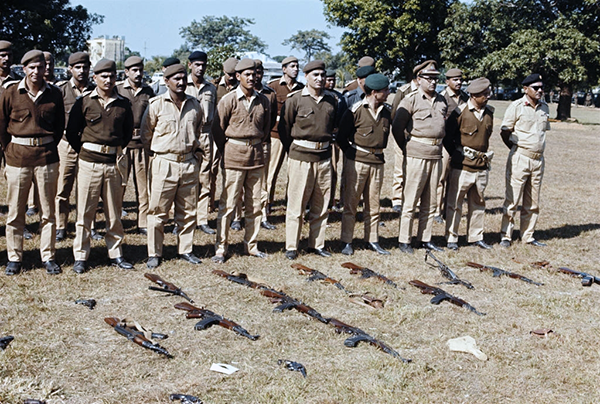

The 1971 War for the liberation of Bangladesh was a landmark and path breaking conflict. In a Cold War era, where the balance of nuclear terror had ensured that no conflict could ever be decisive, it signaled the dawn of a new era of decisive wars against a nuclear backdrop at the global level. The two super powers would ensure that their clients did not fall and, hence, all conflicts of that era ended as tame stalemates. The 1971 War was a trailblazer event. It was a just and decisive war. How do we define a decisive war? It is characterized by three features. It entails a march on an enemy capital. It brings about regime change and is characterized by mass surrenders. The 1971 War was a brilliant tri-Service campaign, a textbook model which (for the first time after World War II) exhibited all three hallmarks of a Decisive Victory.
Grand Strategy
India had a clear Grand Strategy. A Treaty of Peace & Friendship was signed with USSR to stave off American and Chinese intervention. A concerted information war campaign was launched at the global, regional and local levels to highlight Pakistan’s brutal genocide in Bangladesh. India showed strategic patience and restraint, prepared methodically for eight months and only then launched the coup de main operations in the East. This too was done after Pakistan attacked our forward air bases. Hence, it was a just war of last resort.
The Eastern Theatre was designated as the Schwerpunkt or decisive theatre of operations. A holding posture was adopted in the West. The Indian Navy blockaded both wings of Pakistan and entirely isolated East Pakistan. The Indian Air Force (IAF) ensured air supremacy in the East. Resources were milked from the Western and Northern theatres to create an over-matching military equation in Bangladesh. Meticulous logistics preparations were made to support three and then a fourth thrust line. Operations were deliberately launched in winter, when the Himalayan passes would be closed and chances of Chinese intervention virtually ruled out. Great risks were taken to ensure superiority in the Eastern Theatre where decisive results were sought. A classical Blitzkrieg was launched in a highly defensible riverine terrain. Pakistani strong points were bypassed as a dash was made to Dacca, the core command and control node. The results of methodical planning and preparation paid off in a spectacular fashion. In just 13 days Indian advancing formations drove over 550 kms deep into Bangladesh and captured the capital city of Dacca. To speed up their advance they used heliborne operations to bounce major rivers over five miles wide and a paradrop at Tangail to cut off the retreat of Pakistani formations into the Dacca triangle. Pakistan was broken in two and a new nation state created with the force of arms. Indian armed forces had changed the map of South Asia forever.
Leadership
India’s military and political leadership had excelled in this war. Mrs Gandhi proved to be a great war leader in the Churchillian mould. The charismatic Fd Mshl Sam Manekshaw provided brilliant leadership along with the Admiral SM Nanda, the Navy chief and the Air Mshl PC Lall, the IAF chief. Then prime strategic planners were Lt Gen JFR Jacob and the DGMO Lt Gen Inder Gill. Perhaps, our best field commander was Lt Gen Sagat Singh, who used heliborne operations to such good effect. In a brilliant and innovative use of missile boats the Indian Navy struck the Pakistani home base of Karachi twice, sank six ships and set the oil farm at Karachi on fire with concerted strikes with the IAF.
Kautilyan Way of War
Very unconsciously India had revived the Kautilyan paradigm of war, which calls for a long and concerted asymmetric campaign to destabilize and break the balance of the enemy state before delivering the coup de grace operations in a short swift attack using massed elephants to generate shock and awe. The Mukti Bahini launched an eight months long campaign to tire out the Pakistani Army. The brutal response of the Pakistan Army thoroughly alienated the population of Bangladesh. Indian air power delivered shock and awe (including precision attacks on the Governor’s house) and, in just 13 days, the Army columns marched 550 kms to capture the capital, Dacca. This was a classic ‘Expanding Torrent’ campaign that bypassed enemy centres of resistance and raced for the key command and control target of Dacca to induce an organisational collapse of the Pakistani Army in the East.
A Tribute to Gen Bipin Rawat
I had the privilege of being Gen Rawat’s instructor at Indian Military Academy Dehradun. He had won the Sword of Honour there and never looked back. He served extensively in various combat environments and gained valuable experience which was to serve him in great stead as the Army Chief. He went on to be the first Chief of Defense Staff (CDS). To his credit, he revolutionised India’s highly lethargic and red tape mired arms acquisition system. In fact, he brought a paradigm shift in this archaic process. He was in a great hurry to reduce 17 single Service commands to just 4 Tri-Service commands. People felt this would generate great organizational turbulence at a time when external and internal threats were at their maximum. He tenaciously held on to his vision. He was a great change agent in a military set up which is highly traditional and averse to change. His untimely death has been a tragic loss for the nation and the Armed Forces.


















